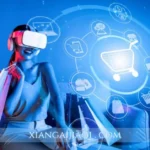Introduction to Severedbytes and its mission
Welcome to the world of Severedbytes, where technology meets innovation and sparks creativity. At Severedbytes, our mission is simple: to uncover the latest tech trends that will shape our future. As we dive into 2022, it’s essential to stay ahead of the curve and understand how these advancements will impact our lives. From artificial intelligence that learns from us, to virtual realities that transport us into new worlds, tech trends are evolving rapidly.
In this blog post, we’ll explore five tech trends severedbytes making waves this year. We’ll also take a closer look at their implications across various industries like healthcare and finance. With insights from industry experts providing forecasts for what’s next, you won’t want to miss out on what’s unfolding in the realm of technology! Let’s embark on this journey together as we unveil the innovations reshaping our landscape—starting right now!
Top 5 Tech Trends for 2022:
Artificial Intelligence and Machine Learning continue to reshape industries. These technologies automate processes, enhance decision-making, and create personalized experiences for users.
Virtual and Augmented Reality are pushing boundaries in entertainment, education, and training. By immersing users in digital environments or overlaying information on the real world, they foster engaging interactions.
The Internet of Things (IoT) connects devices like never before. Smart homes, wearables, and industrial applications collect data that improves efficiency and convenience across various sectors.
Cybersecurity remains critical as cyber threats evolve. Companies are investing heavily in protecting sensitive information from breaches while ensuring compliance with regulations.
5G Technology is revolutionizing connectivity by offering faster speeds and lower latency. This advancement enables innovations such as smart cities and enhanced remote work capabilities that were previously unimaginable.
– Artificial Intelligence and Machine Learning
Artificial Intelligence (AI) and Machine Learning (ML) are reshaping the tech landscape in unprecedented ways. They’re not just buzzwords; they represent a shift toward smarter systems that learn from data.
Businesses leverage AI to automate processes and enhance decision-making. Machine learning algorithms analyze vast datasets, uncovering patterns that humans might miss. This capability is revolutionizing sectors from retail to manufacturing.
In healthcare, for instance, AI assists doctors in diagnosing diseases more accurately by predicting outcomes based on historical data. In finance, it helps detect fraud with remarkable efficiency.
The potential applications are limitless, ranging from personalized marketing campaigns to self-driving vehicles. As more industries adopt these technologies, the demand for skilled professionals will surge.
However, ethical considerations arise as well—such as biases in algorithms or privacy concerns related to data collection. The conversation around responsible AI use continues alongside its rapid development.
– Virtual and Augmented Reality
Virtual and augmented reality are reshaping the way we interact with technology. These immersive experiences transport users into digital realms, blending real-world elements with virtual enhancements.
Gaming is a prominent area where VR has made waves. Players can step inside their favorite games, experiencing adventures like never before. This interactivity enhances engagement and brings storytelling to life.
In education, AR offers innovative ways to learn complex subjects. Imagine dissecting a virtual frog or exploring ancient civilizations through 3D models right in your classroom.
Healthcare isn’t left behind either; surgical simulations allow medical professionals to practice procedures without any risk. The potential for training and patient care improvement is immense.
As these technologies evolve, industries will continue to discover new applications that push boundaries further than ever before. Expect a surge of creativity and innovation as they become mainstream tools rather than novelties.
– Internet of Things (IoT)
The Internet of Things (IoT) is more than just a buzzword. It’s transforming how we live and work. Everyday devices are now interconnected, sharing data seamlessly.
From smart thermostats that learn your preferences to wearable health monitors tracking vital signs, IoT enhances convenience and efficiency. Imagine controlling your home appliances from your smartphone while you’re miles away; that’s the power of IoT at play.
Industries are also getting smarter. In agriculture, for instance, sensors monitor soil moisture levels in real time, optimizing irrigation practices. This leads to better yields and resource conservation.
However, the rise of IoT brings challenges too. Security concerns loom large as more devices connect online. Protecting sensitive information is paramount as our reliance on these technologies grows.
As innovations continue to unfold within this landscape, businesses must adapt quickly or risk falling behind in the competitive race driven by connectivity.
– Cybersecurity
Cybersecurity is not just a tech buzzword; it’s a necessity in today’s digital landscape. With the rise of sophisticated cyber threats, businesses are prioritizing their security measures more than ever before.
Data breaches can cost companies millions and damage reputations. As hackers evolve, so must our defenses. Innovative strategies like zero-trust architecture and advanced encryption techniques are gaining traction.
Moreover, the human element remains crucial. Training employees to recognize phishing attempts or social engineering tactics is vital for any organization’s cybersecurity framework.
Emerging technologies such as AI play a dual role here. They help identify vulnerabilities but also present new risks if mismanaged. Striking that balance will be essential moving forward.
As industries grow reliant on technology, effective cybersecurity frameworks will determine who thrives and who falters in this fast-paced environment. Staying informed about these developments is key for organizations looking to safeguard their assets.
– 5G Technology
5G technology is revolutionizing connectivity. It offers lightning-fast speeds and ultra-reliable connections, promising to change how we communicate and interact with the world.
This next generation of wireless communication enables real-time data transfer. As a result, applications in various sectors can operate seamlessly, from smart cities to autonomous vehicles.
In healthcare, 5G allows for remote surgeries and telemedicine advancements. Doctors can monitor patients more effectively without geographical barriers.
The entertainment industry also stands to benefit immensely. Streaming high-definition content will become smoother than ever with minimal buffering issues.
However, alongside its advantages come challenges. The infrastructure required for widespread 5G implementation poses significant investment hurdles.
Security concerns must not be overlooked either. With increased connectivity comes a greater risk of cyber threats that demand robust protective measures.
Impact of these trends on various industries such as healthcare, finance, and education
The impact of tech trends like AI and IoT on healthcare is profound. These technologies enable more accurate diagnostics and personalized treatment plans. Remote monitoring tools are transforming patient care, making it possible to track health metrics in real-time.
In finance, machine learning algorithms help detect fraud faster than ever. They analyze patterns that a human might overlook, providing security and increasing trust in digital transactions. Blockchain technology also enhances transparency, reducing the risk of financial crimes.
Education is not left behind either. Virtual reality offers immersive learning experiences that can engage students like never before. Meanwhile, online platforms powered by AI provide tailored educational content based on individual needs.
Each industry faces unique challenges yet stands to benefit significantly from these emerging technologies as they evolve further into everyday practices.
Interviews with experts in each trend to provide insight and predictions for the future
At Severedbytes, we believe in the power of expert insights to illuminate tech trends. Our interviews with industry leaders reveal fascinating predictions about the future landscape.
For instance, a leading AI researcher discusses how machine learning will revolutionize personalized healthcare. Their focus is on predictive analytics that could tailor treatments based on individual genetic profiles.
In another conversation, an augmented reality innovator shares thoughts on immersive education experiences. They envision classrooms where students interact with 3D models of historical events or scientific phenomena.
We also tapped into cybersecurity experts who stress the importance of proactive measures against evolving threats. Their opinions highlight emerging technologies like blockchain for enhancing data security.
Telecom specialists foresee 5G enabling unprecedented connectivity, paving the way for smarter cities and seamless IoT integration. Each perspective adds depth to our understanding of these transformative tech trends at Severedbytes.
Challenges and ethical considerations surrounding these technologies
As technology continues to evolve at a rapid pace, it brings with it both exciting possibilities and significant challenges. The innovations highlighted in the tech trends severedbytes article are powerful tools that can revolutionize industries. However, they also raise important ethical considerations that must not be overlooked.
Artificial intelligence and machine learning offer incredible capabilities but pose risks related to privacy, bias, and job displacement. It’s crucial for developers and companies to be mindful of how these systems impact individuals’ lives. Clear guidelines should be established to mitigate potential harm while maximizing benefits.
Virtual and augmented reality have transformed experiences across sectors, yet they also present challenges regarding addiction, social isolation, and the blurring of real-world boundaries. As users immerse themselves in virtual environments more frequently, we must consider what this means for mental health and human interaction.
The Internet of Things (IoT) enhances connectivity but introduces vulnerabilities as devices become interconnected. Cybersecurity measures need continual improvement to protect sensitive data from breaches or malicious attacks. Users must remain vigilant about their digital footprint while manufacturers prioritize security protocols.
Cybersecurity itself is an ever-evolving battlefield where new threats emerge daily. As organizations adopt advanced technologies, they face the challenge of safeguarding against sophisticated attacks without stifling innovation or user experience.
5G technology promises faster connections but comes with concerns around surveillance capabilities and increased electromagnetic exposure. Society must navigate these implications carefully as networks expand globally.
By addressing these ethical issues head-on through discussions among technologists, policymakers, businesses, and communities alike—stakeholders can forge a path that embraces innovation responsibly while ensuring safety and equity for all involved in our increasingly digitized world.






